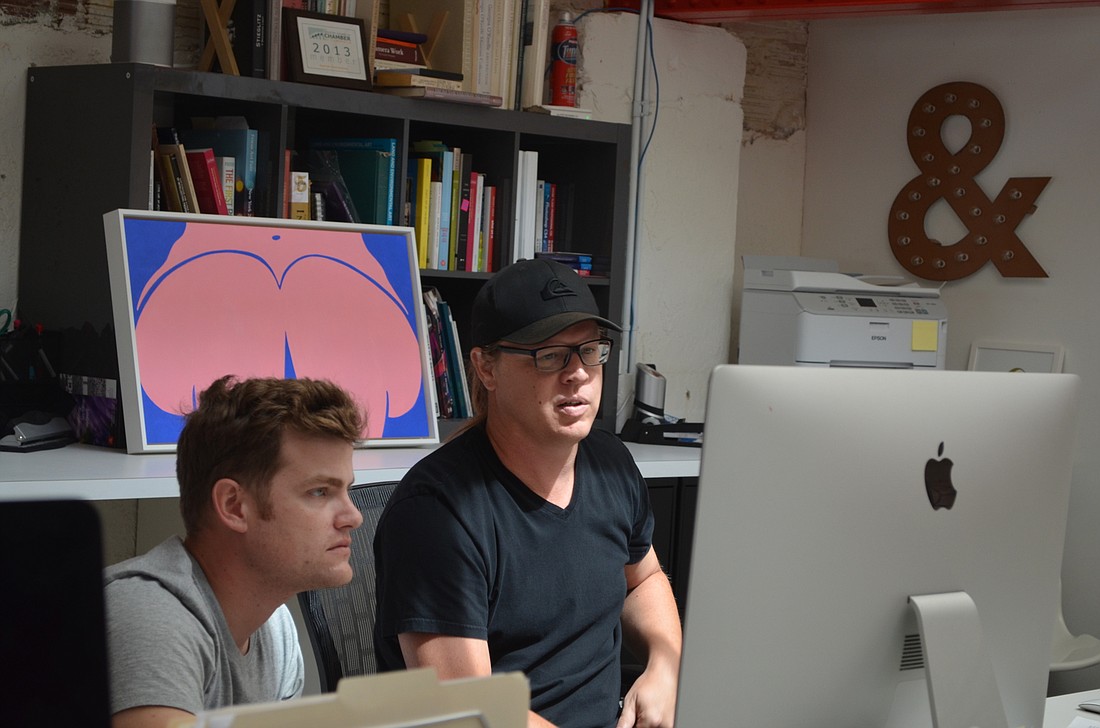- April 26, 2025
-
-
Loading

Loading

Visual artists have a reputation for being the lone wolves of the art world. They tend to hole themselves up in their studios, perfecting their latest works until the final big reveal.
But for Sam Alfstad, owner of Alfstad& Contemporary, some of the best creative ideas are born not out of isolation, but through collaboration.
When he opened the Rosemary District gallery in 2014, that mindset was at the center of his vision for the space. Not only did he want to showcase the works of renowned artists — he also wanted to work with them.
“It just seemed natural,” he says. “Coming from an advertising background, everything we did was a group process. Everything I know about major movements progressing in the art world happened through collaboration — artists would get together in coffee houses, and new ideas were born. I wanted to help create something like that here.”
Alfstad& Contemporary’s latest exhibition, a group show called /& Editions, closes its third season with a retrospective show featuring works by eight previously shown artists who have now collaborated with the gallery to create limited-edition prints, using Alfstad’s onsite printing studio.
A Learning Experience
Discretely tucked away behind a hidden door on one of the Alfstad gallery walls is a state-of-the-art printing studio. Alfstad opens the door to reveal a room outfitted with several large-scale Epson printers, as well as screen-printing and silkscreen equipment. The studio allows the gallery and artists to experiment with different techniques and see the results immediately — something he says is rare in the industry.
Here, he says, each artist teamed up with Chris Schumaker, a Ringling College printmaking graduate, who’s been with Alfstad& Contemporary for the last two years. Together, they combined modern and traditional printmaking processes to reimagine the artists’ work.
“This is the perfect way to see what we mean when we talk about contemporary art,” says Alfstad. “It’s artists working with contemporary materials in a new way — using workaday items, like printers, to create something new that could never be made without contemporary tools.”
He points to several prints of artist Michael Taylor’s studio glass. To translate the artist’s works to the two-dimensional realm, Taylor and Schumaker worked with photos of the brightly colored glass sculptures, meticulously framing and cropping them to look at something familiar in a new way.
“It’s a very give-and-take process,” says Schumaker. “Most of these artists have never worked in this medium before, so it was a learning experience to trade ideas and reproduce their vision. You’ve got painters, sculptors and studio-glass artists all in one show. It’s exciting to see their works come together in a new light.”
A Quest for Curiosity
Michael Wyshock, a painter and professor at Ringling College, embraced the opportunity whole-heartedly. He says the process was a chance for him to immerse himself in the collaborative process — something he says he learned to appreciate from his previous work creating art for musicians.
“Collaborating is such a normal thing in so many other art forms,” he says. “But you don’t see it very often in visual art. Seeing how musicians work together — like a family — made me really open to the concept.”
Most of Wyshock’s work uses multicolored, hand-painted pixels to explore fractal light and repeated patterns. It’s a tedious process, he says, usually taking months. But working with Schumaker, he was able to digitally scan his work and experiment with different colors and compositions in real time — an eye-opening experience.
“Being able to experiment with almost anything I want, without restriction, it was one of the coolest things,” he says. “It got to the point where the process was actually informing my paintings, instead of the other way around. It’s like learning a new instrument.”
And the process isn’t just beneficial for the artists. Creating limited-edition prints also makes the work more affordable to collectors — especially young, new collectors, says Alfstad.
For Wyshock, the show marks a rare opportunity for Sarasota to distinguish itself in the national art scene, and he says it’s a step toward creating more opportunities for artists to work together and explore possibilities locally.
“There are limits to what I can do as an individual artist,” he says. “I could never do any of this in my studio. We plateau without collaboration. You have to let down barriers and be open to the process. It’s not about being more vulnerable — it’s about being more curious.”